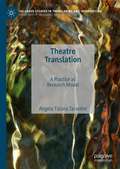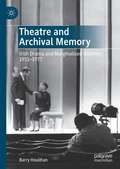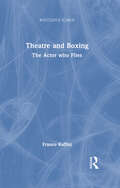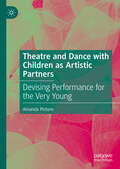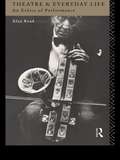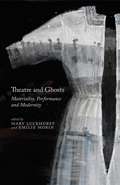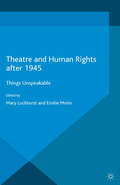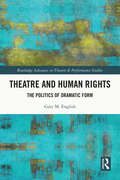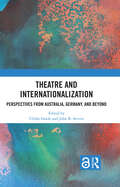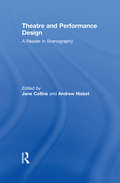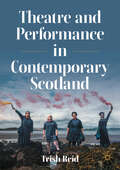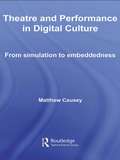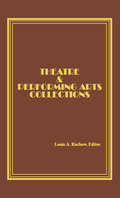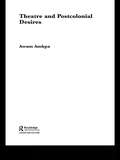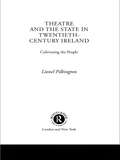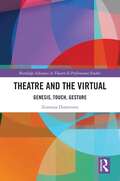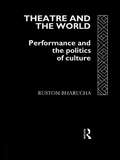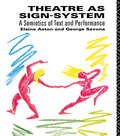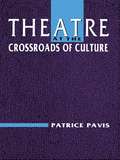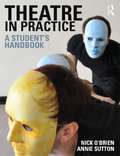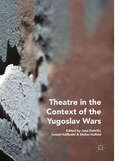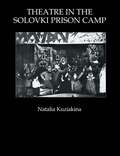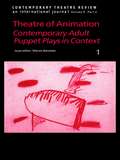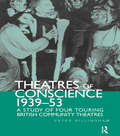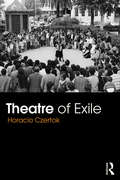- Table View
- List View
Theatre Translation: A Practice as Research Model (Palgrave Studies in Translating and Interpreting)
by Angela Tiziana TarantiniThis book examines the effects of translation on theatrical performance. The author adapts and applies Kershaw et al.’s Practice as Research model to an empirical investigation analysing the effects of translation on the rhythm and gesture of a playtext in performance, using the contemporary plays Convincing Ground and The Gully by Australian playwright David Mence which have been translated into Italian. The book is divided into two parts: a theoretical exegesis encompassing Translation Studies, Performance Studies and Gesture Studies, and a practical investigation comprising of a workshop where excerpts of the plays are explored by two groups of actors. The chapters are accompanied by short clips of the performance workshop hosted on SpringerLink. The book will be of interest to students and scholars in the fields of Translation Studies (and Theatre Translation more specifically), Theatre and Performance, and Gesture Studies.
Theatre and Archival Memory: Irish Drama and Marginalised Histories 1951-1977
by Barry HoulihanThis book presents new insights into the production and reception of Irish drama, its internationalisation and political influences, within a pivotal period of Irish cultural and social change. From the 1950s onwards, Irish theatre engaged audiences within new theatrical forms at venues from the Pike Theatre, the Project Arts Centre, and the Gate Theatre, as well as at Ireland’s national theatre, the Abbey. Drawing on newly released and digitised archival records, this book argues for an inclusive historiography reflective of the formative impacts upon modern Irish theatre as recorded within marginalised performance histories. This study examines these works' experimental dramaturgical impacts in terms of production, reception, and archival legacies. The book, framed by the device of ‘archival memory’, serves as a means for scholars and theatre-makers to inter-contextualise existing historiography and to challenge canon formation. It also presents a new social history of Irish theatre told from the fringes of history and reanimated through archival memory.
Theatre and Boxing: The Actor who Flies (Routledge Icarus)
by Franco RuffiniTheatre and Boxing focuses on a problem which is of paramount importance for any theatre practitioner and researcher: the actor’s believable body. This problem has been taken up by Stanislavski, Meyerhold, Artaud, Brecht, Decroux, Copeau, Grotowski, and many others. It is an essential hurdle for all who practice the theatrical craft or want to study it theoretically. This hurdle can be considered one of the foundations of theatre science and of the relationship between technique, politics and ethics. This book tells the story of a revolution in the work of the actor in the early- and mid-20th century, a period in which the focus of theatrical interest shifted from the emotions to the body. The actor’s body became a tool for purveying a dynamic set of actions which often transformed the very actor himself. This new centrality of the body also drew attention to those places in which the body is central: the gym, the boxing ring and the circus with its trapezes and tightropes became, together with the stage, laboratories for the theatre. Thus, in addition to the reformers of the theatre the pages of this book are filled with boxers, acrobats, gymnasts and wrestlers, pursuers of an utopia: the "actor who flies".
Theatre and Dance with Children as Artistic Partners: Devising Performance for the Very Young
by Amanda PintoreThis book offers a methodological framework for developing research-based Theatre and Dance for the Very Young (TDVY) performances in which artists collaborate with children ages 0-6 and their caregivers and/or educators as creative partners in the process. It provides a detailed investigation of all stages of the work including: designing and executing a creative research plan, analyzing tools for assessment, using research results as the foundation of a devising process, and outcomes for final performances for this age range. This process reflects on years of creative research with very young children, the results of which include methods for building collaborative performances with a variety of institutions such as early childhood centers, universities, community spaces, and non-profit arts organizations. The main themes addressed in this book are innovative methods for devising and collaboration, the translation of research into performance, and the integral bonds between early childhood development and artistic experiences.
Theatre and Everyday Life: An Ethics of Performance
by Alan ReadAlan Read asserts that there is no split between the practice and theory of theatre, but a divide between the written and the unwritten. In this revealing book, he sets out to retrieve the theatre of spontaneity and tactics, which grows out of the experience of everyday life. It is a theatre which defines itself in terms of people and places rather than the idealised empty space of avant garde performance. Read examines the relationship between an ethics of performance, a politics of place and a poetics of the urban environment. His book is a persuasive demand for a critical theory of theatre which is as mentally supple as theatre is physically versatile.
Theatre and Ghosts: Materiality, Performance and Modernity
by M. Luckhurst E. MorinTheatre and Ghosts brings theatre and performance history into dialogue with the flourishing field of spectrality studies. Essays examine the histories and economies of the material operations of theatre, and the spectrality of performance and performer.
Theatre and Human Rights after 1945: Things Unspeakable
by Mary Luckhurst Emilie MorinThis volume investigates the rise of human rights discourses manifested in the global spectrum of theatre and performance since 1945. Essays address topics such as disability, discrimination indigenous rights, torture, gender violence, genocide and elder abuse.
Theatre and Human Rights: The Politics of Dramatic Form (ISSN)
by Gary M. EnglishThis book develops theoretical intersections between theatre and human rights and provides methodologies to investigate human rights questions from within the perspective of theatre as a complex set of disciplines.While human rights research and programming often employ the arts as representations of human rights-related violations and abuses, this study focuses on dramatic form and structure, in addition to content, as uniquely positioned to interrogate important questions in human rights theory and practice. This project positions theatre as a method of examination in addition to the important purposes the arts serve to raise consciousness that accompany other, often considered more primary modes of analysis. A main feature of this approach includes emphasis on dialectical structures in drama and human rights and integration of applied theatre and critical ethnography with more traditional theatre. This integration will demonstrate how theatre and human rights operates beyond the arts as representation model, offering a primary means of analysis, activism, and political discourse.This book will be of great interest to theatre and human rights practitioners and activists, scholars, and students.
Theatre and Internationalization: Perspectives from Australia, Germany, and Beyond
by Ulrike Garde John R. SevernTheatre and Internationalization examines how internationalization affects the processes and aesthetics of theatre, and how this art form responds dramatically and thematically to internationalization beyond the stage. With central examples drawn from Australia and Germany from the 1930s to the present day, the book considers theatre and internationalization through a range of theoretical lenses and methodological practices, including archival research, aviation history, theatre historiography, arts policy, organizational theory, language analysis, academic-practitioner insights, and literary-textual studies. While drawing attention to the ways in which theatre and internationalization might be contributing productively to each other and to the communities in which they operate, it also acknowledges the limits and problematic aspects of internationalization. Taking an unusually wide approach to theatre, the book includes chapters by specialists in popular commercial theatre, disability theatre, Indigenous performance, theatre by and for refugees and other migrants, young people as performers, opera and operetta, and spoken art theatre. An excellent resource for academics and students of theatre and performance studies, especially in the fields of spoken theatre, opera and operetta studies, and migrant theatre, Theatre and Internationalization explores how theatre shapes and is shaped by international flows of people, funds, practices, and works.
Theatre and Performance Design: A Reader in Scenography
by Jane Collins Andrew NisbetTheatre and Performance Design: A Reader in Scenography is an essential resource for those interested in the visual composition of performance and related scenographic practices. Theatre and performance studies, cultural theory, fine art, philosophy and the social sciences are brought together in one volume to examine the principle forces that inform understanding of theatre and performance design. The volume is organised thematically in five sections: looking, the experience of seeing space and place the designer: the scenographic bodies in space making meaning This major collection of key writings provides a much needed critical and contextual framework for the analysis of theatre and performance design. By locating this study within the broader field of scenography – the term increasingly used to describe a more integrated reading of performance – this unique anthology recognises the role played by all the elements of production in the creation of meaning. Contributors include Josef Svoboda, Richard Foreman, Roland Barthes, Oscar Schlemmer, Maurice Merleau-Ponty, Richard Schechner, Jonathan Crary, Elizabeth Wilson, Henri Lefebvre, Adolph Appia and Herbert Blau.
Theatre and Performance in Contemporary Scotland
by Trish ReidThis textbook offers a detailed and expansive account of theatre and performance in contemporary Scotland. It considers the underlying historical and cultural developments that have enabled the recent renaissance in Scottish theatre and the emergence of playwrights of international standing, such as David Greig, Zinnie Harris, David Harrower and Rona Munro as well as companies of significant international note. Some prominence is given to the National Theatre of Scotland, which was established in 2004 in the aftermath of Scottish devolution, and which has become a key organization in the creating and dissemination – nationally and internationally – of Scottish theatre and performance. The book aims to capture the diversity and eclecticism of Scotland’s contemporary performance culture by examining work across a spectrum from children’s theatre, community theatre, mainstream theatre for adult audiences and live and performance art.
Theatre and Performance in Digital Culture: From Simulation to Embeddedness (Routledge Advances in Theatre & Performance Studies)
by Matthew CauseyTheatre and Performance in Digital Culture examines the recent history of advanced technologies, including new media, virtual environments, weapons systems and medical innovation, and considers how theatre, performance and culture at large have evolved within those systems. The book examines the two Iraq wars, 9/11 and the War on Terror through the lens of performance studies, and, drawing on the writings of Giorgio Agamben, Alain Badiou and Martin Heidegger, alongside the dramas of Beckett, Genet and Shakespeare, and the theatre of the Kantor, Foreman, Socíetas Raffaello Sanzio and the Wooster Group, the book positions theatre and performance in technoculture and articulates the processes of aesthetics, metaphysics and politics. This wide-ranging study reflects on how the theatre and performance have been challenged and extended within these new cultural phenomena.
Theatre and Performing Arts Collections
by Lee AshHere is an exciting book that provides detailed descriptions of dozens of the most important and unique collections of “theatricana” in the United States and Canada. In Theatre and Performing Arts Collections, distinguished theatre specialists, librarians, and curators describe the unique possessions of the best and largest collections in theatre and performing arts. Each chapter provides detailed descriptions of the collections, as well as important notes about their history--information that is not available in any other source!
Theatre and Postcolonial Desires (Routledge Advances in Theatre & Performance Studies #No.1)
by Awam AmkpaThis book explores the themes of colonial encounters and postcolonial contests over identity, power and culture through the prism of theatre. The struggles it describes unfolded in two cultural settings separated by geography, but bound by history in a common web of colonial relations spun by the imperatives of European modernity. In post-imperial England, as in its former colony Nigeria, the colonial experience not only hybridized the process of national self-definition, but also provided dramatists with the language, imagery and frame of reference to narrate the dynamics of internal wars over culture and national destiny happening within their own societies. The author examines the works of prominent twentieth-century Nigerian and English dramatists such as Wole Soyinka, Femi Osofisan, Davd Edgar and Caryl Churchill to argue that dramaturgies of resistance in the contexts of both Nigerian as well as its imperial inventor England, shared a common allegiance to what he describes as postcolonial desires. That is, the aspiration to overcome the legacies of colonialism by imagining alternative universes anchored in democratic cultural pluralism. The plays and their histories serve as filters through which Ampka illustrates the operation of what he calls 'overlapping modernities' and reconfigures the notions of power and representation, citizenship and subjectivity, colonial and anticolonial nationalisms and postcoloniality. The dramatic works studied in this book embodied a version of postcolonial aspirations that the author conceptualises as transcending temporal locations to encompass varied moments of consciousness for progressive change, whether they happened during the hey day of English imperialism in early twentieth-century Nigeria, or in response to the exclusionary politics of the Conservative Party in Thatcherite England. Theatre and Postcolonial Desires will be essential reading for students and researchers in the areas of drama, postcolonial and cultural studies.
Theatre and the State in Twentieth-Century Ireland: Cultivating the People
by Lionel PilkingtonThis major new study presents a political and cultural history of some of Ireland's key national theatre projects from the 1890s to the 1990s. Impressively wide-ranging in coverage, Theatre and the State in Twentieth-Century Ireland: Cultivating the People includes discussions on: *the politics of the Irish literary movement at the Abbey Theatre before and after political independence; *the role of a state-sponsored theatre for the post-1922 unionist government in Northern Ireland; *the convulsive effects of the Northern Ireland conflict on Irish theatre. Lionel Pilkington draws on a combination of archival research and critical readings of individual plays, covering works by J. M. Synge, Sean O'Casey, Lennox Robinson, T. C. Murray, George Shiels, Brian Friel, and Frank McGuinness. In its insistence on the details of history, this is a book important to anyone interested in Irish culture and politics in the twentieth century.
Theatre and the Virtual: Genesis, Touch, Gesture (Routledge Advances in Theatre & Performance Studies)
by Zornitsa DimitrovaTheatre and the Virtual lays out a set of conceptual instruments for the articulation and engendering of the forces of theatrical potentiality. Creating a passage toward a reconstitution of the given, a theatre of the virtual opens bodies in motion to a region of an ongoing genesis of forces. The outcome: regimes of constraint are abandoned through a radical practice of ecological attunement. Violence is eschewed through an onto-ecology of touch. Closed systems are repotentialised to become co-constitutive of their environments. A logic of spectrality settles in—not so much entities as atmospheres, not so much a being as a style of being, not so much a body as multitudinous milieus of response. This is the task of a theatre of the virtual—to safeguard the possibility of the extra-epistemological and uphold one’s right to offer accounts of oneself from outside of being, all the while creating a fractured record of the wondrous mutations of a moving, gesturing body. This book will be of great interest to students and scholars in theatre, philosophy, new materialisms, environmental humanities, gesture, and the ontology of response.
Theatre and the World: Performance and the Politics of Culture
by Rustom BharuchaIn this passionate and controversial work, director and critic Rustom Bharucha presents the first major critique of intercultural theatre from a 'Third World' perspective. Bharucha questions the assumptions underlying the theatrical visions of some of the twentieth century's most prominent theatre practitioners and theorists, including Antonin Artaud, Jerzsy Grotowski, and Peter Brook. He contends that Indian theatre has been grossly mythologised and taken out of context by Western directors and critics. And he presents a detailed dramaturgical analysis of what he describes as an intracultural theatre project, providing an alternative vision of the possibilities of true cultural pluralism. Theatre and the World bravely challenges much of today's 'multicultural' theatre movement. It will be vital reading for anyone interested in the creation or discussion of a truly non-Eurocentric world theatre.
Theatre as Sign System: A Semiotics of Text and Performance
by Elaine Aston George SavonaThis invaluable student handbook is the first detailed guide to explain in detail the relationship between the drama text and the theory and practice of drama in performance. Beginning at the beginning, with accessible explanations of the meanings and methods of semiotics, Theatre as Sign System addresses key drama texts and offers new and detailed information about the theories of performance.
Theatre at the Crossroads of Culture
by Patrice PavisWestern culture has a long and fraught history of cultural appropriation, a history that has particular resonance within performance practice. Patrice Pavis asks what is at stake politically and aesthetically when cultures meet at the crossroads of theatre.? A series of major recent productions are analysed, including Peter Brook's Mahabharata, Cixous/Mnouchkine's Indiande, and Barba's Faust. These focus discussions on translation, appropriation, adaptation, cultural misunderstanding, and theatrical exploration. Never losing sight of the theatrical experience, Pavis confronts problems of colonialism, anthropology, and ethnography. This signals a radical movement away from the director and the word, towards the complex relationship between performance, performer, and spectator. Despite the problematic politics of cultural exchange in the theatre, interculturalism is not a one-sided process. Using the metaphor of the hourglass to discuss the transfer between source and target culture, Pavis asks what happens when the hourglass is turned upside down, when the `foreign' culture speaks for itself.
Theatre in Practice: A Student's Handbook
by Nick O'Brien Annie SuttonTheatre in Practice provides students with all of the ‘must have’ Drama skills required for A-Level, International Baccalaureate, BTEC and beyond. Practical, step-by-step exercises and diagrams give access to the key figures and processes central to drama, including: Stanislavski, Brecht, Lecoq and Berkoff devising theatre rehearsing and performing monologues and duologues how to approach directing a play improvising. Each chapter offers advice for both students and teachers, with notes and follow-on exercises ideal for individual study and practice. Written by specialists with extensive experience leading workshops for the 'post 16' age-group, Theatre in Practice is a thorough and imaginative resource that speaks directly to students.
Theatre in the Context of the Yugoslav Wars
by Jana Dolečki Senad Halilbašić Stefan HulfeldThis book assembles texts by renowned academics and theatre artists who were professionally active during the wars in former Yugoslavia. It examines examples of how various forms of theatre and performance reacted to the conflicts in Serbia, Croatia, Bosnia and Herzegovina, Slovenia, and Kosovo while they were ongoing. It explores state-funded National Theatre activities between escapism and denial, the theatre aesthetics of protest and resistance, and symptomatic shifts and transformations in the production of theatre under wartime circumstances, both in theory and in practice. In addition, it looks beyond the period of conflict itself, examining the aftermath of war in contemporary theatre and performance, such as by considering Ivan Vidić’s war trauma plays, the art campaigns of the international feminist organization Women in Black, and Peter Handke’s play Voyage by Dugout. The introduction explores correlations between the contributions and initiates a reflection on the further development of the research field. Overall, the volume provides new perspectives and previously unpublished research in the fields of theory and historiography of theatre, as well as Southeast European Studies.
Theatre in the Solovki Prison Camp (Russian Theatre Archive Ser. #Vol. 3.)
by Natalia KuziakinaFirst Published in 1996. Routledge is an imprint of Taylor & Francis, an informa company.
Theatre of Animation (Contemporary Theatre Review Ser. #Vols. 9, Pts. 4.)
by Marion BaraitserPublished in 1999, 'Theatre of Animation' is a valuable addition to the field of performance.
Theatre of Conscience 1939-53: A Study of Four Touring British Community Theatres
by Peter BillinghamTheatres of Conscience offers an invaluable and essential insight into four touring British theatre companies whose work and contributions to post-war British theatre have largely gone unnoticed. Combining a rigorous scholarly evaluation of their work and their broadly ideological and ethical contribution to wider post-war developments in British theatre. Peter Billingham offers the reader a unique insight into four companies which, motivated by enthusiasm, principles and creative innovation, sought to take the theatre of conscience to theatre-less communities in wartime Britain and during the following decade. Contemporaries of - amongst others - Joan Littlewood's Theatre Workshop, the Pilgrim Players, the Adelphi Players, the Compass Players and the Century Theatre represent a significant but rather overlooked phase in the development of twentieth-century British theatre.
Theatre of Exile
by Horacio CzertokHow might the organic link between theatre-making and political action be revitalised? And how might a spontaneous vision of a theatre of and for ordinary people be reignited? Since his political exile from Argentina in 1977, theatre director and producer Horacio Czertok has devoted his life to re-imagining the art of the theatre, taking it out of its comfort zone into places of social conflict such as deprived suburban areas, prisons and mental hospitals, as well as open, public spaces, engaging directly with audiences in a spirit of abiding, carnivalesque, and deeply political theatrical experimentation. Adapting a rigorous Stanislavskian theatrical training to the exigencies of raw, immediate encounters with audiences in marginal and open spaces, Czertok’s theatre-making is unique, not only in the kinds of capacities and skills it allows actors to develop, but also in the way it renders the question of political efficacy immanent to the very process of making theatre. Providing Czertok’s own, highly personal account of his trajectory in the global scene of theatre-making over the past half-century, this is a book about the theatre of exile – a theatre of streets, prisons, hospitals, open to direct and unexpected encounters with audiences and their life-experiences. Photos by Luca Gavagna
